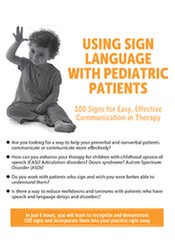

In this recording, you will learn to recognize and demonstrate 100 signs and incorporate them into your practice right away.
Sign language isn't only used by the Deaf community; it is often used by children with general speech and language delays and disorders, developmental delays, childhood apraxia of speech (CAS), autism spectrum disorder, Down syndrome, and hearing loss. One effective way to communicate with this population is through sign language. However, many don't have time to become fluent in American Sign Language (ASL). Course instructor, Jill Eversmann, is here to help! In this recording, you will learn to recognize and demonstrate 100 basic signs, the manual alphabet, and numbers from 1-20 as well as how to incorporate them into your practice immediately.
| File type | File name | Number of pages | |
|---|---|---|---|
| Manual - Using Sign Language with Pediatric Patients (7.65 MB) | 124 Pages | Available after Purchase |
JILL EVERSMANN, MS, CCC-SLP, is a pediatric Speech-Language Pathologist and sign language instructor in Columbia, SC. She is the owner of Speech Signs, LLC, which offers speech therapy services and sign language instruction. She has over 30 years of experience, most of which has been with children aged birth-five years old. She loves working with young children and their families as well as sharing her knowledge and expertise with other professionals. Ms. Eversmann is a dynamic presenter and a sought-after speaker. Her seminars offer crucial information, innovative ideas and effective techniques that attendees will be able to use immediately in their practices.
Ms. Eversmann received her Bachelor of Science degree in Speech-Language Pathology from James Madison University and her Master of Science degree in Speech-Language Pathology from Towson State University. She holds a Certificate of Clinical Competence from the American Speech Language Hearing Association and is licensed by the state of South Carolina.
Speaker Disclosures:
Financial – Receives a speaking honorarium from Vyne Education.
Non-financial – No relevant non-financial relationship exists.
Please wait ...